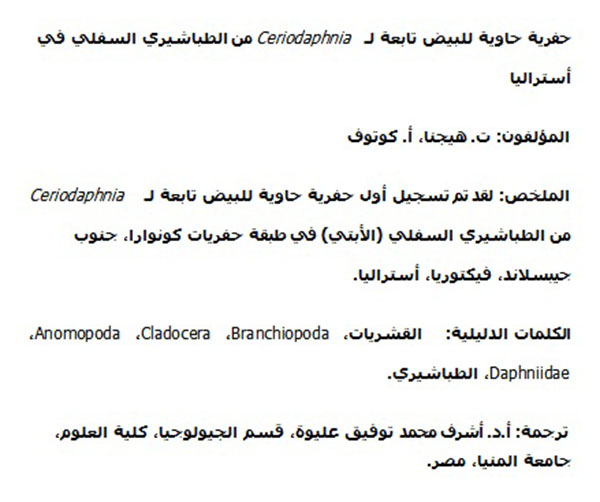Ephippia belonging to Ceriodaphnia Dana, 1853 (Cladocera: Anomopoda: Daphniidae) from the Lower Cretaceous of Australia
Plain Language Abstract
Cladocerans are tiny (majority are less than 1 mm, a few are about 5–6 mm long), dominantly freshwater, free-swimming crustaceans. Many of them (in the Order Anomopoda) produce resting eggs within a protective case called an ephippium. Ephippia have a number of characteristics that allow us to tell, sometimes even at the species level (number of eggs inside, shape, ornamentation). The resistant nature of the ephippia give them a higher likelihood of making it into the fossil record. Their small size, however, often means that they are difficult to spot as fossils. Cladoceran body fossils are likewise rarely observed—despite being a ubiquitous part of freshwater ecosystems, their bodies are not mineralized or sclerotized and thus they decay away easily.
In 1986, paleontologists Jell and Duncan identified some putative cladoceran body fossils from the Lower Cretaceous Koonwarra fossil bed in Victoria, Australia. They classified these body fossils within the anomopod cladoceran family Daphnidae. However, the fossils have no identifiable synapomorpies that they share with cladocerans aside from size and shape, which they also share with juvenile clam shrimp. Thus, the body fossils must be regarded as indeterminate diplostracans.
Jell and Duncan also identified fossil cladoceran ephippia. They formally assigned the ephippia to the subfamily Daphniidae, but speculated in the text that the ephippia may belong to extant genera like Simocephalus or Ceriodaphnia. After analyzing the ephippia, we have found that some of them have the same shape and egg characteristics as modern members of Ceriodaphnia. Thus, we assign these ephippia to Ceriodaphnia sp. The presence of Ceriodaphnia-type ephippia alongside Simocephalus-type ephippia (identified by Fryer in 1991) supports the notion that the Daphniidae have deep roots in the Mesozoic, and that Ceriodaphnia was dispersed to at least two continents by the early Cretaceous.
Resumen en Español
Efipios pertenecientes a Ceriodaphnia Dana, 1853 (Cladocera: Anomopoda: Daphniidae) del Cretácico Inferior de Australia
Se informa de los primeros efipios fósiles (exuvias de cladóceros que contienen huevos en reposo) pertenecientes al género actual Ceriodaphnia (Anomopoda: Daphniidae) de la roca lacustre del Cretácico Inferior del Koonwarra Fossil Bed (Grupo Strzelecki), Sur de Gippsland, Victoria, Australia. Representan el segundo registro de efipios de cladóceros fósiles pre-cuaternarios para Australia (Ceriodaphnia y Simocephalus, ambos de Koonwarra). La presencia de ambos géneros es aproximadamente coincidente con la primera aparición de estos géneros en otras partes (i.e., Mongolia). Esto sugiere que la radiación temprana de los Daphniidae anomópodos es anterior a la desintegración de Pangea. Además, se revisan algunos fósiles corporales putativos de cladóceros de la misma localidad; aunque son consistentes con el tamaño y la forma de los cladóceros, no poseen sinapomorfias específicas de cladóceros. Por lo tanto, son considerados como diplostráceos indeterminados.
Palabras clave: Crustacea; Branchiopoda; Cladocera; Anomopoda; Daphniidae; Cretácico.
Traducción: Enrique Peñalver (Sociedad Española de Paleontología)
Résumé en Français
Des éphippies appartenant à Ceriodaphnia Dana, 1853 (Cladocera : Anomopoda : Daphniidae) du Crétacé inférieur d'Australie
Les premières éphippies (exuvies de cladocères contenant les œufs de résistance) fossiles appartenant au genre actuel Ceriodaphnia (Anomopoda : Daphniidae) sont signalées dans le Crétacé inférieur (Aptien) des dépôts de milieu d'eau douce du « Koonwarra Fossil Bed » (groupe Strzelecki, Gippsland Sud, État de Victoria, Australie). Elles représentent seulement le second signalement d'éphippies fossiles de cladocères plus anciennes que le Quaternaire en Australie (Ceriodaphnia et Simocephalus, les deux provenant de Koonwarra). L'occurrence de ces deux genres coïncide grossièrement avec la première occurrence de ces genres ailleurs (en Mongolie). Cela suggère que la radiation ancienne des anomopodes daphniidés est antérieure à la dislocation de la Pangée. De plus, certains fossiles de corps supposés appartenir à des cladocères et provenant de cette même localité sont également révisés : bien qu'ils soient cohérents en termes de taille et de forme avec les cladocères, ils ne possèdent aucune des synapomorphies des cladocères. Ils sont donc considérés comme des diplostracés indéterminés.
Mots-clés: Crustacea ; Branchiopoda ; Cladocera ; Anomopoda ; Daphniidae ; Crétacé
Translator: Antoine Souron
Deutsche Zusammenfassung
Ephippia von Ceriodaphnia Dana, 1853 (Cladocera: Anomopoda: Daphniidae) aus der unteren Kreide von Australien
Es wird über die ersten Epihippia-Fossilien (ein cladoceranes Exuvium mit Dauereiern) berichtet. Sie gehören der heutigen Gattung Ceriodaphnia (Anomopoda: Daphniidae) an und stammen aus den unterkretazischen (Aptium) Frischwassser Koonwarra Fossillagerstätten (Strzelecki Gruppe), South Gippsland, Victoria, Australien. Sie stellen erst den zweiten Nachweis (prä-quartärer) fossiler cladocerer Epihippia aus Australien dar (Ceriodaphnia und Simocephalus sind beide aus Koonwarra). Das Vorkommen beider Gattungen stimmt ungefähr mit dem ersten Auftreten dieser Gattungen andernorts (i.e. Mongolei) überein. Dies legt nahe, dass die frühe Radiation der daphniiden Anomopoden dem Auseinanderbrechen von Pangaea vorausging. Zusätzlich werden einige mutmaßliche Cladoceren -Körperfossilien aus der gleichen Fundstelle überprüft. Obwohl diese in Größe und Form mit den Cladoceren übereinstimmen zeigen sie keine für Cladoceren typische Synapomorphien und werden daher als Diplostraca indet. betrachtet.
Schlüsselwörter: Crustacea; Branchiopoda; Cladocera; Anomopoda; Daphniidae; Kreide.
Translator: Eva Gebauer
Arabic

Translator: Ashraf M.T. Elewa

